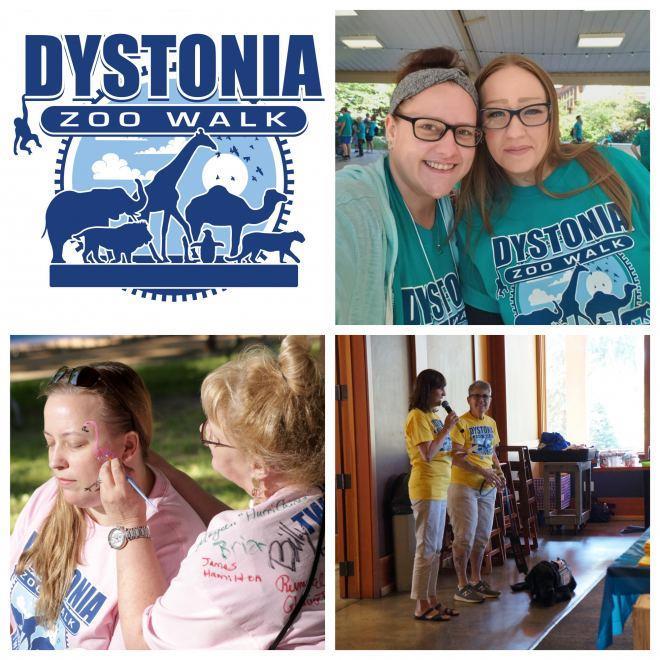Everybody's Zooing It! Thousands Attend Dystonia Zoo Walks to Find a Cure for Disabling Brain Disorder
(MENAFN- PRLog) CHICAGO - July 29, 2019 -PRLog-- Dystonia Zoo Walks are not your typical charity walk. The purpose of these events is to increase awareness ofdystonia , a little-known but surprisingly common neurological disorder. Proceeds support the Dystonia Medical Research Foundation (DMRF), which funds medical research toward a cure and programs for affected individuals and families. Zoo Walks attract 5,000+ participants annually.
The 4th Twin Cities Dystonia Zoo Walk on June 22 was organized by Shanna and Brad Schmitt, Billy McLaughlin, and the Minnesota Dystonia Support Group. Brad Schmitt developed cervical dystonia, affecting his neck. Cervical dystonia is among the most common types of dystonia.
"For me, the zoo walks represent a local, tangible hope for more connections, more treatments, and a cure," says Shanna Schmitt. "Every year, we reach more people who now know what dystonia is. We're actually part of the solution when we participate locally."
The 6th Detroit Dystonia Zoo Walk took place July 14. DMRF Community Leadership Council Member Rosemary Young organizes the event in honor of her young son Kavin, who has dystonia.
The 4th Portland Dystonia Zoo Walk, organized by Dee Linde and members of the Portland, Oregon & Southwest Washington Dystonia Support Group, was July 20. Linde developed dystonia as a result of prescribed medications. She was among the first dystonia patients to undergo deep brain stimulation (DBS).
Upcoming Dystonia Zoo Walks are taking place in St. Louis, Cleveland, Bronx/NYC, Pittsburgh, Providence, Cincinnati, Philadelphia, Toledo, Phoenix, and Los Angeles.
Dystonia Zoo Walks do not have a formal walking course or required distance. National sponsors include Ipsen and Allergan.
Dystonia is a chronic, often disabling, neurological disorder marked by excessive, involuntary muscle contractions that cause abnormal body movements and postures. Common signs include abnormal movements of the head and neck, excessive blinking, a breathy or choking voice, hand cramps, or a twisted foot. Dystonia impacts people of all ages and backgrounds.
The Dystonia Medical Research Foundation is a 501(c)(3) non-profit organization dedicated to advancing research for improved dystonia treatments and a cure, promoting awareness, and supporting the well-being of affected individuals and families.
Contact
Dystonia Medical Research Foundation
***@dystonia-foundation.org
Photo:
https://www.prlog.org/12781707/1
The 4th Twin Cities Dystonia Zoo Walk on June 22 was organized by Shanna and Brad Schmitt, Billy McLaughlin, and the Minnesota Dystonia Support Group. Brad Schmitt developed cervical dystonia, affecting his neck. Cervical dystonia is among the most common types of dystonia.
"For me, the zoo walks represent a local, tangible hope for more connections, more treatments, and a cure," says Shanna Schmitt. "Every year, we reach more people who now know what dystonia is. We're actually part of the solution when we participate locally."
The 6th Detroit Dystonia Zoo Walk took place July 14. DMRF Community Leadership Council Member Rosemary Young organizes the event in honor of her young son Kavin, who has dystonia.
The 4th Portland Dystonia Zoo Walk, organized by Dee Linde and members of the Portland, Oregon & Southwest Washington Dystonia Support Group, was July 20. Linde developed dystonia as a result of prescribed medications. She was among the first dystonia patients to undergo deep brain stimulation (DBS).
Upcoming Dystonia Zoo Walks are taking place in St. Louis, Cleveland, Bronx/NYC, Pittsburgh, Providence, Cincinnati, Philadelphia, Toledo, Phoenix, and Los Angeles.
Dystonia Zoo Walks do not have a formal walking course or required distance. National sponsors include Ipsen and Allergan.
Dystonia is a chronic, often disabling, neurological disorder marked by excessive, involuntary muscle contractions that cause abnormal body movements and postures. Common signs include abnormal movements of the head and neck, excessive blinking, a breathy or choking voice, hand cramps, or a twisted foot. Dystonia impacts people of all ages and backgrounds.
The Dystonia Medical Research Foundation is a 501(c)(3) non-profit organization dedicated to advancing research for improved dystonia treatments and a cure, promoting awareness, and supporting the well-being of affected individuals and families.
Contact
Dystonia Medical Research Foundation
***@dystonia-foundation.org
Photo:
https://www.prlog.org/12781707/1

Legal Disclaimer:
MENAFN provides the
information “as is” without warranty of any kind. We do not accept
any responsibility or liability for the accuracy, content, images,
videos, licenses, completeness, legality, or reliability of the information
contained in this article. If you have any complaints or copyright
issues related to this article, kindly contact the provider above.
Most popular stories
Market Research

- Bitmex And Tradingview Announce Trading Campaign, Offering 100,000 USDT In Rewards And More
- Japan Halal Food Market Size To Surpass USD 323.6 Billion By 2033 With A CAGR Of 8.1%
- Chicago Clearing Corporation And Taxtec Announce Strategic Partnership
- Red Lions Capital And Neovision Launch DIP.Market Following ADGM Regulatory Notification
- Poppy Seed Market Size, Share, In-Depth Insights, Opportunity And Forecast 2025-2033
- Pluscapital Advisor Empowers Traders To Master Global Markets Around The Clock






















Comments
No comment